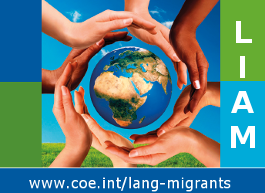Politiche linguistiche per migranti adulti
Le politiche linguistiche che gli Stati membri mettono in vigore per i migranti adulti devono prima di tutto adattarsi agli obiettivi e ai principi di accoglienza cui sono soggetti. Questi principi possono solo essere interpretati qui come principi generali del Consiglio d'Europa: la promozione dei diritti umani, il pluralismo democratico, lo Stato di diritto e ogni azione volta a sostenere misure di coesione sociale.
Obiettivi di formazione per migranti adulti
Preliminarmente gli Stati membri devono riconoscere le loro specifiche responsabilità in relazione all‘offerta di formazione linguistica per l’utenza di riferimento. Il supporto linguistico deve avere obiettivi che assicurino in particolare un livello di competenza nella comunicazione orale, elemento cruciale della vita sociale, specie nei luoghi di lavoro (dominio professionale). Tuttavia lo stesso supporto dovrebbe anche generare un senso di appartenenza al nuovo ambiente sociale (dominio pubblico), tenendo conto del fatto che tale senso è correlato al tipo di progetto migratorio (ad esempio insediamento permanente o temporaneo). Una politica di integrazione di successo, infine, non può non prevedere interventi adeguati per contenere le paure e rimuovere le ambiguità che la presenza visibile dei nuovi arrivati può innescare nella società di accoglienza. Le iniziative di educazione interculturale a tutti rivolte (a partire dalla scuola dell'obbligo) sono auspicabili per accrescere la consapevolezza in merito a siffatti temi. In tal senso l'integrazione è chiaramente un processo a due vie.
Progettazione di formazione linguistica per migranti adulti
L'attuazione pratica dei principi d’accoglienza dipende dalla struttura della formazione linguistica, vale a dire dall'approccio generale adottato per lo sviluppo dei corsi rivolti a migranti. Diversi gli aspetti da considerare:
- profiling the learner groups concerned; for instance, “training course for migrants” does not suffice as a classification, as migrants’ language repertoires and knowledge of the host society can vary considerably;
- defining the language needs, ie the spoken and written communication situations which the migrants wish to be able to cope with, particularly in the language of the host society, but also using all the other language resources at their disposal;
- on the basis of the target situations identified, specifying learning objectives in terms of activities and descriptors of activities based on the Common European Framework of Reference for Languages (CEFR), by types of discourse (work conversation, discussion of current events, presentations, etc) and by domain such as family life, work, social life, etc;( for instance, being able to read listings of TV programmes);
- deciding on relevant objectives in terms of the structure of spoken and written texts vocabulary, morphology and syntax, etc, drawing on the reference level descriptions of the CEFR (when available) and adapting these, especially in terms of vocabulary, to the needs and expectations of migrants;
- dividing these objectivesinto sequences of activities , taking particular account of the teaching time available;
- defining the organisation of these sequences of activities;
- giving pride of place to active and self-directed teaching/learning, while taking very careful account of the learners’ educational culture, in other words, their learning habits and their expectations regarding the teaching;
- organising these sequences of activities within the available teaching time, bearing in mind the pace of learning;
- testing and having learners self-assess what has been learnt.
Quality of language training for adult migrants
Apart from the technical characteristics designed to ensure that the training on offer meets the adult migrants’ training needs, it is essential regularly to assess the overall quality of the training in terms, for instance, of the qualifications required of trainers or the relevance of training resources, external auditing of the training programmes, seeking the opinions of students and other stakeholders (employers, for instance) and overall assessment of the outcomes of training. These monitoring and quality assurance mechanisms are an essential part of managing training of this kind and assessing its impact.
The training provision should also include, as vital, cross-cutting elements:
- highlighting the value of migrants’ languages of origin in group activities in order, inter alia, to encourage their maintenance and transmission from generation to generation;
- raising awareness about how the host society works in terms of its structures and cultural and social diversity, with a view to stimulating learners to react to these and to examine these features in greater depth.
In this sense language policies for integration can be a worthwhile collective “investment”, as they contribute to social cohesion. However,explicit principles like those mentioned above may be undermined either because of technical shortcomings (which the resources on this website seek to remedy) or because they mask a policy of exclusuon in which knowledge of the language(s) of the host society is used to restrict access to it. In cases,where the design of language training is applied without social principles,it is insufficient to stem the long term.adverse effects.
JCB
Related resources
Concept Paper: The role of languages in policies for the integration of adult migrants, 2008, Jean-Claude Beacco
Adult migrant integration policies: Principles and implementation, 2010, Jean-Claude Beacco
The ‘Common European Framework of Reference for Languages’ and the development of policies for the integration of adult migrants, 2008, David Little
The linguistic integration of adult migrants and the CEFR, David Little, 2012.
Quality assurance in the provision of language education and training for adult migrants – Guidelines and options, 2008 - Richard Rossner
Learning the language of the host country for professional purposes, 2012, Claire Extramiana
Providers of courses for adult migrants- Self-assessment Handbook, 2012, Richard Rossner
Integration of Adult Migrants and Education : Extracts from Council of Europe Conventions, Recommendations and Resolutions (1968-2015)




